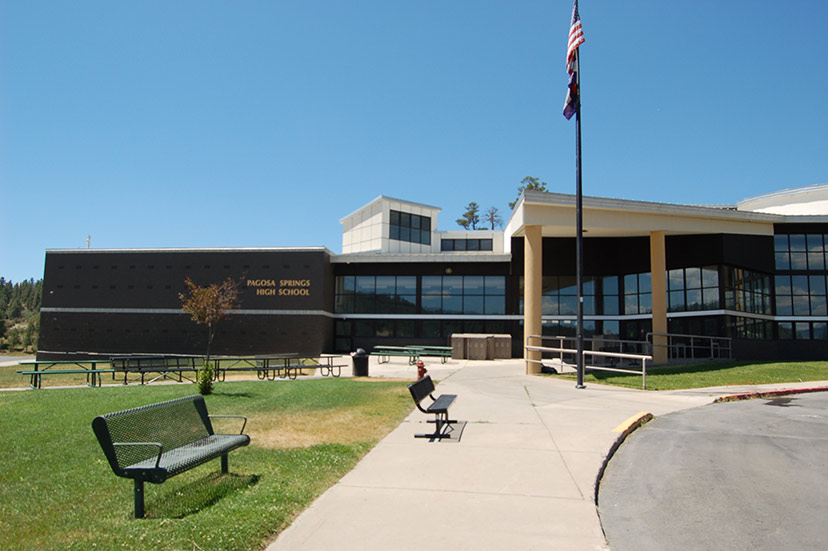PHOTO: Pagosa Springs High School, summer 2023.
A couple of weeks ago, Wisconsin Governor Tony Evers signed into law a new state budget that stands to increase public school funding by $325 per pupil, every year…
… until the year 2425, four centuries from now.
The Governor accomplished this remarkable feat through the clever use of his ‘partial-veto’ powers. He deleted “20” and the hyphen from the legislation’s reference to the “2024-25” school year. He explained that his action would “provide school districts with predictable long-term increases for the foreseeable future.”
Governor Evers’ approach to public school funding didn’t come up in discussions by Archuleta School District’s MLO (Mill Levy Override) advisory committee, but the committee was in fact looking into the future as the discussions proceeded.
The long-range future, in fact.
I mentioned in Part One that I currently serve on the Pagosa Peak Open School Board of Directors, and as such, have a fiduciary duty to the school’s financial health, given that ASD shares a portion of the current MLO funding with PPOS — as they will also do, with any future MLO funding.
Assuming that such future funding is approved by District voters.
It was from that perspective that I participated in the MLO committee, organized by ASD and led by Denver-based consultant Lynea Hansen.
Ms. Hansen had enlisted the help of a law firm to help develop some draft ballot language, and she enlisted the help of consultants at Keating Research to test that draft ballot language in a survey of 300 registered Archuleta County voters.
We’ll be discussing that survey later.
First, though, we ought to consider the very idea of a Mill Levy Override.
The funding for public schools in Colorado is defined by the Colorado General Assembly, when they annually approve a bill typically titled, “Public School Finance”. The bill providing for the 2023-2024 school year was SB23-287.
SB23-287 increases the statewide base “per pupil funding” for the 2023-24 budget year by $598.25, to account for inflation, and sets the target number for the 2023-24 budget year at not less than $9.1 billion. (‘billion’ with a ‘b’.)
The bill specifies that for the purpose of any law, with certain exceptions, that applies to or exempts a public entity or a public official, a charter school has the same status as a school district, and certain persons affiliated with the charter school have the same status as a complementary counterpart in a school district. Furthermore, the bill clarifies the application of certain laws to charter schools.
The basic assumption behind the Public School Finance bill is that each school in Colorado ought to be funded at the same amount, per student. That is to say, students attending a school district in a rich community, with high property tax valuations, should not have an unfair educational advantage over students in a poor community with meager property tax collections. So the state government sets a basic funding level for all school districts, and then blends local property taxes with additional money from state income tax collections and other sources.
To ‘level the playing field’, so to speak.
Basically, no matter what kind of economy your community has, and no matter what decisions are made by your local school board, the funding for public schools will amount to $10,614 per pupil. (Approximately.)
Basically, no matter how much your community pays on property taxes, the state backfills with income tax revenues to deliver $10,614 per student. In some wealthier Colorado communities, local property taxes pay almost the entire bill. In smaller, poorer communities, the state foots most of the bill.
So what happens when a community like Pagosa Springs sees its property taxes skyrocket? The local taxpayers will foot more of the local education budget, and the state will pay less. The property tax increase that we will see next year will make no essential difference to the amount of money Archuleta School District has to spend.
A 60% increase in Pagosa Springs property taxes will mean a great deal to many property owners and renters. It will mean, essentially, nothing at all to the funding of our local public schools.
But local voters have the ability to spend additional amounts on their students, if the community is willing to approve a ‘Mill Levy Override’. This special type of property tax does not get included in the $10,614 per student funding. Typically, an MLO is approved for a special purpose.
In 2018, the School District voters approved an MLO of $1.7 million per year — an additional property tax mill levy — to increase staff salaries, hire school resource officers, and to help fund full-day kindergarten. But in 2019, the Colorado legislature funded full-day kindergarten across the state, and the ASD Board of Education decided to forego the collection of that portion of the MLO. So, since 2019, ASD has been collecting a total of $1.5 million per year from property owners.
The 2018 MLO was presented as a temporary measure, set to expire in 2025. The School Board felt that a temporary MLO was more likely to be approved by the voters, because it would give the voters an opportunity to confirm that the money was used as promised, before renewing the MLO.
The key question facing the MLO advisory committee was: Should the District put the renewal of the MLO in front of the voters in 2023… or in 2024?
Understanding that new property valuations recently hit the mailboxes in Archuleta County, and certain voters might be having negative feelings about property taxes?
But there were other important questions as well.
To assess the questions, ASD hired Keating Research, at a cost of $18,000, to test draft 2023 ballot language among 300 registered voters.
The results?

